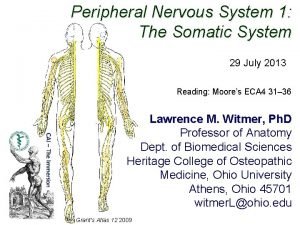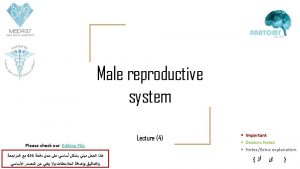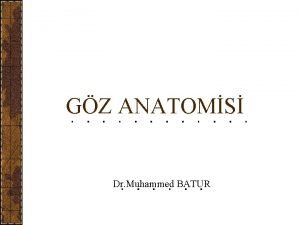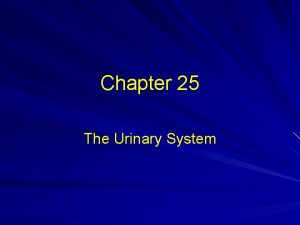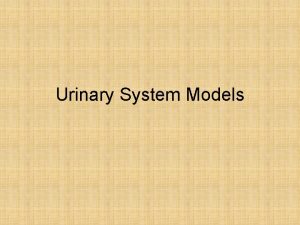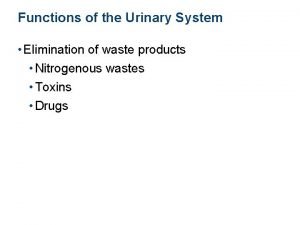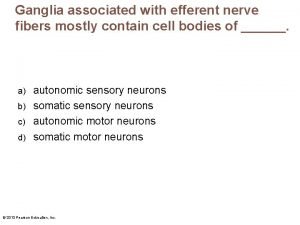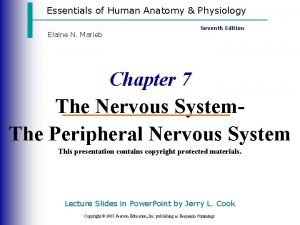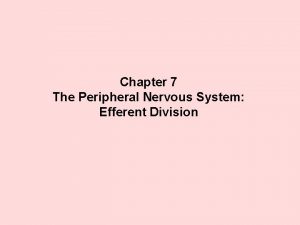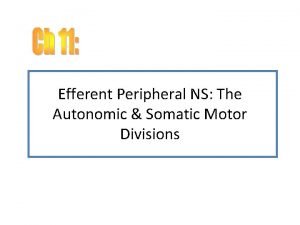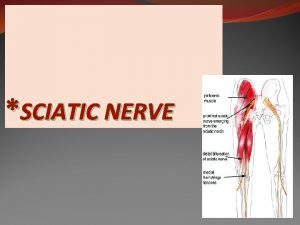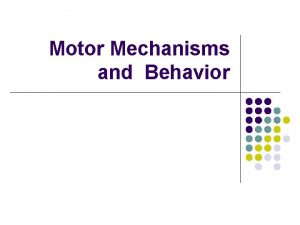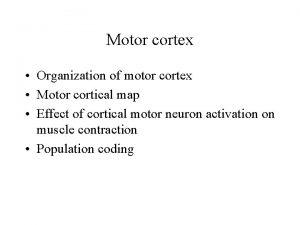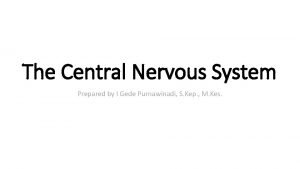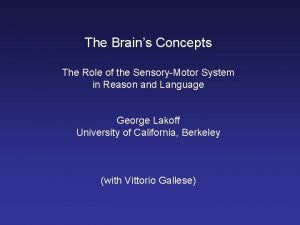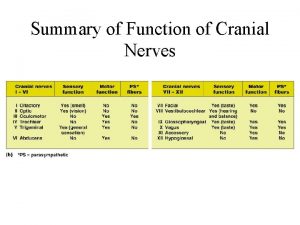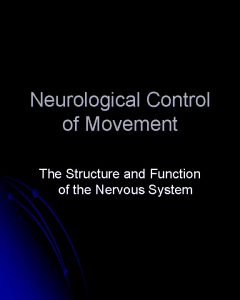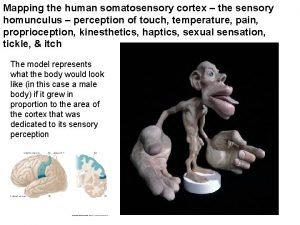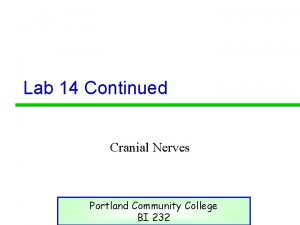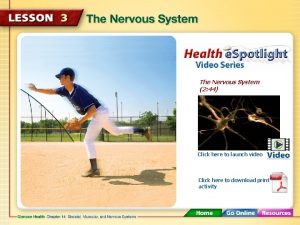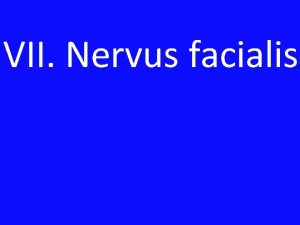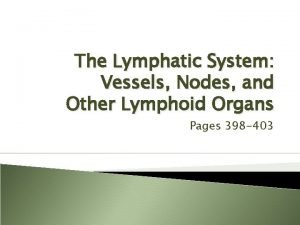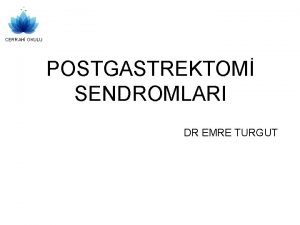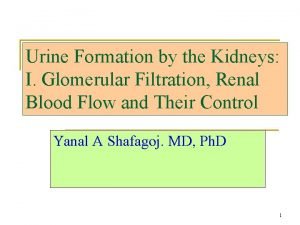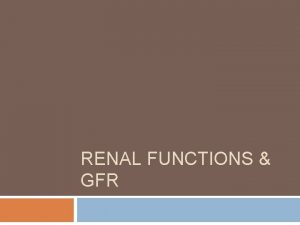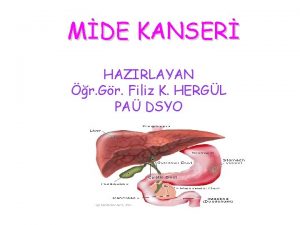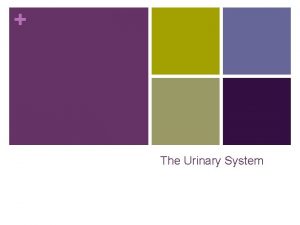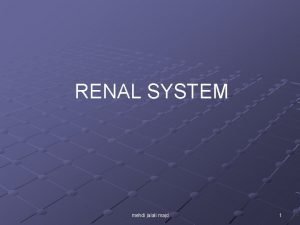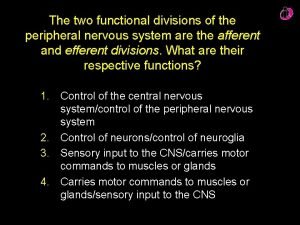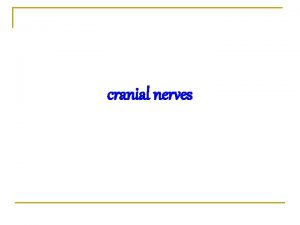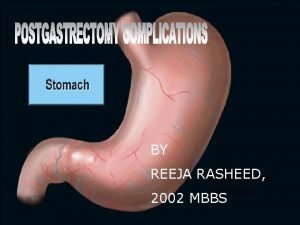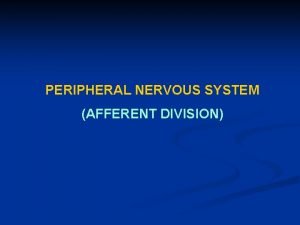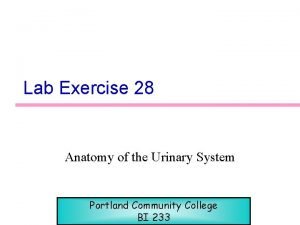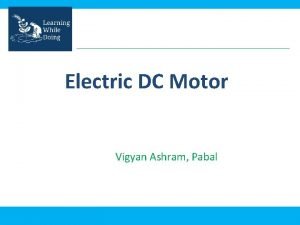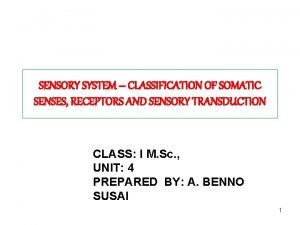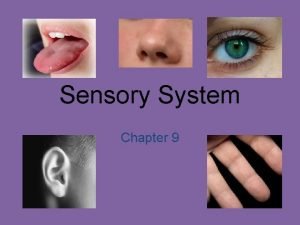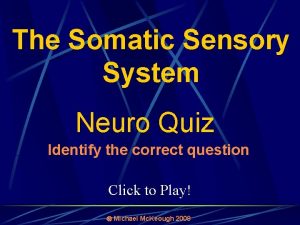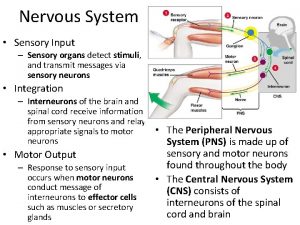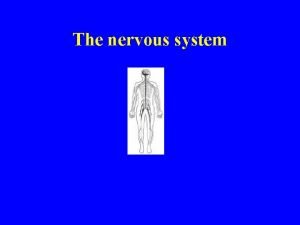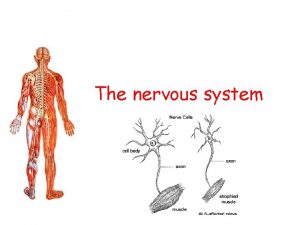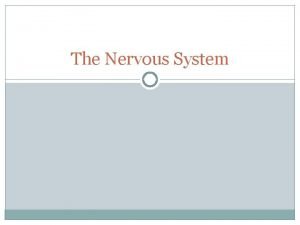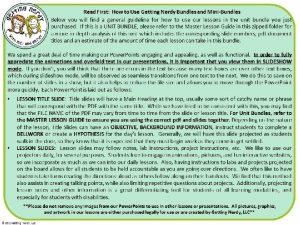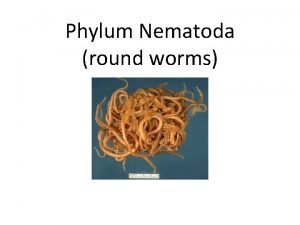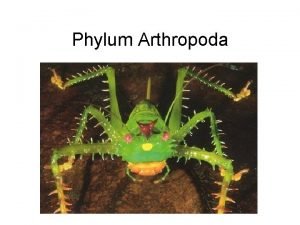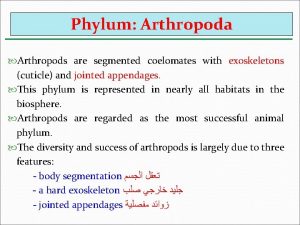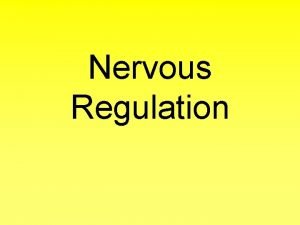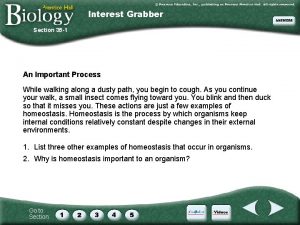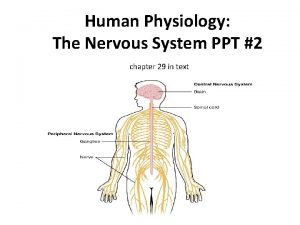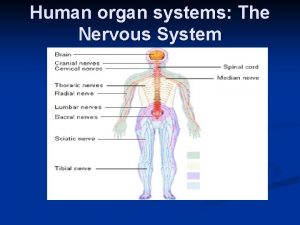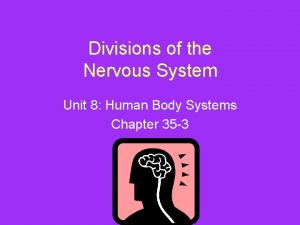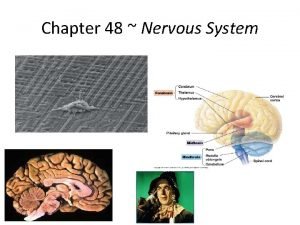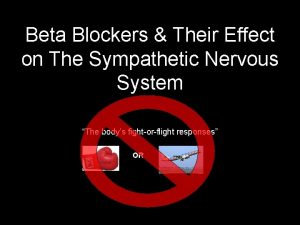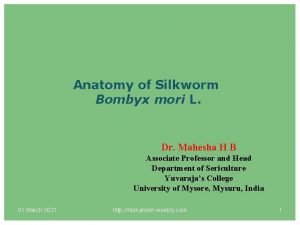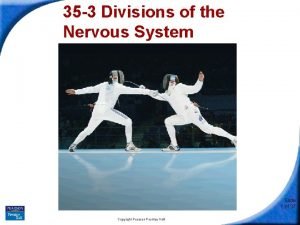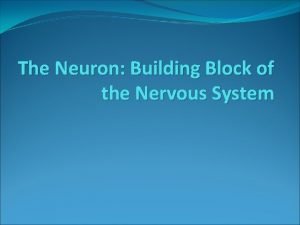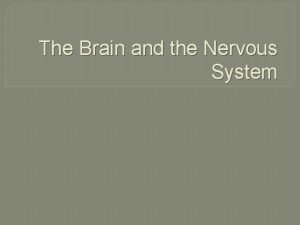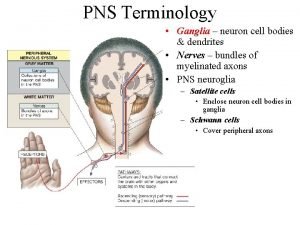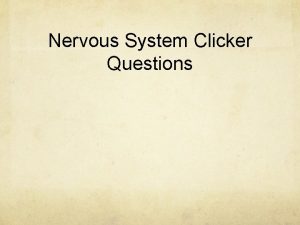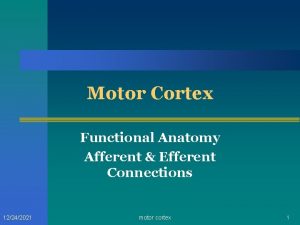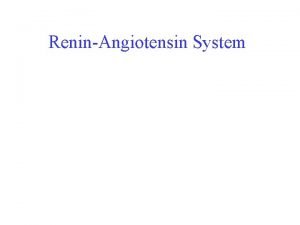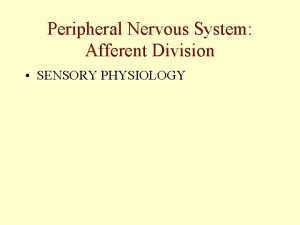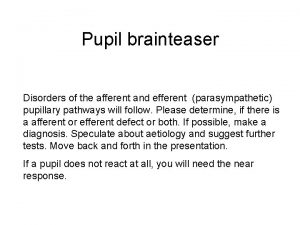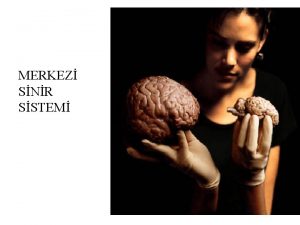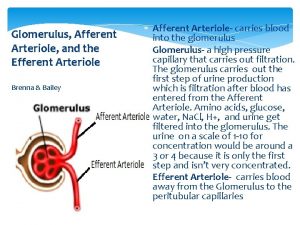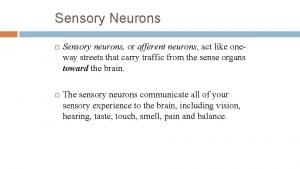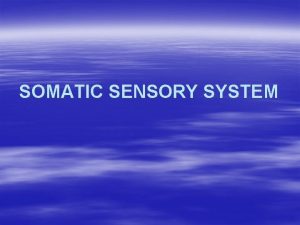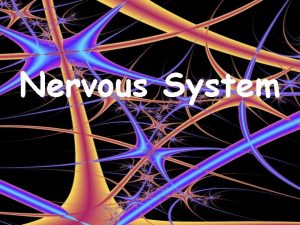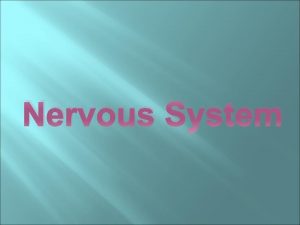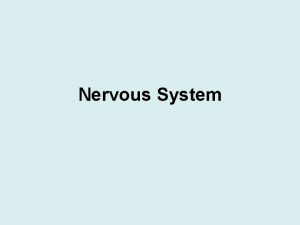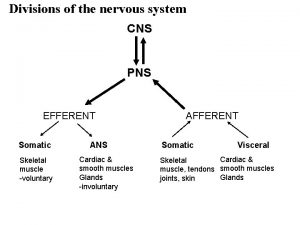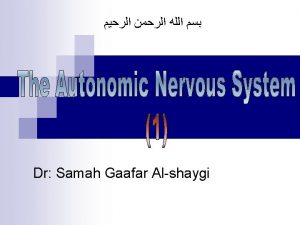Nervous system Afferent Sensory Receive Efferent Motor Integrative














































































































- Slides: 110

Nervous system Afferent: Sensory Receive Efferent: Motor Integrative:

Functions of nervous system Receive: receptors, sensory neurons Store: spinal cord, brain Integrate: spinal cord, brain Create new complexes: brain Respond: motor neurons, muscles, glands Regulate Protect

Sensory, Motor and Integrative Systems



Cerebral Blood Flow, Cerebral Spinal Fluid

Blood. Flowto tothe the. Brain Blood Flow to the Brain Blood to the Brain • brain is highly dependent on blood flow • cessation of flow for 5 -10 seconds results in a loss of consciousness • highly dependent on oxygen delivery

Cerebral Blood Flow to the Brain • 15% of the resting cardiac output (750 -900 ml/min) • related to the metabolic rate of the brain • 3 metabolic factors have potent effects on blood flow - CO 2 - H+ - O 2

Cerebral Blood Flow • An increase in CO 2 increases blood flow. • This is thought to work through an increase in the H+ ion concentration. – CO 2 + H 2 O → H 2 CO 3 → H+ + HCO 3 - • An increase in H+ concentration depresses neuronal activity. • Normal PO 2 35 - 40 mm Hg. • Below 30 mm Hg begin to see increase in flow, below 20 mm Hg coma.

Cerebral Blood Flow • cerebral blood flow is autoregulated – nearly constant over a pressure range of 60 to 140 mm Hg – below 60 mm Hg blood flow begins to fall rapidly – above 140 mm Hg the blood flow increases but most importantly the blood vessels begin to stretch, which can lead to damage and eventual rupture (stroke)

Cerebrospinal fluid (CSF) Site Composition Circulation Functions

Cerebrospinal Fluid (CSF) • Clear fluid. • Circulates through cavities in the brain (ventricles) and the spinal cord (central canal) and also in the subarachnoid space. • Absorbs shock and protects the brain and the spinal cord. • Helps transport nutrients and wastes from the blood and the nervous tissue.

Formation and Circulation of CSF in the Ventricles • Choroid plexuses- networks of capillaries in the walls of the ventricles. • Ventricles are lined by ependymal cells. • Plasma is drawn from the choroid plexuses through ependymal cells into the ventricles to produce CSF.

Cerebrospinal fluid (CSF) volume: 100 -150 ml (wt in pounds) contains: (glucose, proteins, H+, Na+, k+, Ca++, Mg++, Cl. HCO 3 -,

Cerebrospinal fluid (CSF) Mechanical Protection: shock absorber Chemical: homeostasis Circulation

Cerebrospinal fluid (CSF) HYDROCEPHALUS



Circulation of CSF • CSF from the lateral ventricles → interventricular foramina → third ventricle → cerebral aqueduct → fourth ventricle → subarachnoid space or central canal. • CSF is reabsorbed into the blood by arachnoid villi.

Brain Metabolism • highly metabolic organ – 2% of total body mass, yet has 15% of total metabolism of the body • limited anaerobic metabolism – anaerobic breakdown of glycogen cannot supply the energy requirements of the brain – most neuronal activity depends on the second by second delivery of oxygen to the brain

Brain Metabolism • mostly glucose dependent • uptake of glucose into the brain is not dependent on insulin • blood glucose must be maintained for the brain to receive the proper amount of this substrate


Nervous system Afferent: Sensory Receive Efferent: Motor Integrative:

Functions of nervous system Receive: receptors, sensory neurons Store: brain , spinal cord Integrate: brain, spinal cord Create new complexes Respond: Motor neurons, muscles, glands Regulate Protect

Classification of Sensory Receptors Based on the Location • Exteroceptors • Interoceptors • Proprioceptors

Sensation • Conscious and subconscious awareness of changes in the external or internal environment. • Components of sensation: Stimulation of the sensory receptor → transduction of the stimulus → generation of nerve impulses → integration of sensory input.

Classification of Sensory Receptors based on the type of Stimulus • • • Mechanoreceptors Thermoreceptors Nociceptors Photoreceptors Chemoreceptors Osmoreceptors

Classification of Sensory Receptors • General senses: somatic and visceral. Somatic- tactile, thermal, pain and proprioceptive sensations. Visceral- provide information about conditions within internal organs. • Special senses- smell, taste, vision, hearing and equilibrium or balance.

Sensation • Each of the principle types sensation; touch, pain, sight, sound, is called a modality of sensation. • Each receptor is responsive to one type of stimulus energy. Specificity is a key property of a receptor, it underlines the most important coding mechanism, the labeled line. • How the sensation is perceived is determined by the characteristics of the receptor and the central connections of the axon connected to the receptor.

Sensory Receptors in the Skin

Types of Sensory Receptors • Free nerve endings: pain and thermoreceptors. • Encapsulated nerve endings: pacinian corpuscles. • Separate cells: hair cells, photoreceptors and gustatory receptor cells.

Generator Potential and Receptor Potential • Generator potential is produced by free nerve endings, encapsulated nerve endings, and olfactory receptors. When it reaches a threshold, it triggers one or more nerve impulses in the axon of a firstorder sensory neuron. • Receptor potential triggers the release of neurotransmitter → postsynaptic potential → action potential.

Sensory Receptors and their Relation-ship to First. Order Sensory Neurons

Somatic Sensations • Sensory receptors in the skin (cutaneous sensations), muscles, tendons and joints and in the inner ear. • Uneven distribution of receptors. • Four modalities: tactile, thermal, pain and proprioceptive.

Receptor Excitation Figure 46 -3; Guyton & Hall

Relationship between Receptor Potential and Action Potentials Figure 46 -2; Guyton & Hall

Adaptation of Sensory Receptors • Rapidly adapting receptors: receptors that detect pressure, touch and smell. • Slowly adapting receptors: receptors that detect pain, body position, and chemical composition of the blood.

Adaptation of Receptors • When a continuous stimulus is applied, receptors respond rapidly at first, but response declines until all receptors stop firing.

Adaptation • Rate of adaptation varies with type of receptor. • Therefore, receptors respond when a change is taking place (i. e. , think of the feel of clothing on your skin. )

Mechanism of Adaptation • varies with the type of receptor • photoreceptors change the amount of light sensitive chemicals • mechanoreceptors redistribute themselves to accommodate the distorting force (i. e. , the pacinian corpuscle) • some mechanoreceptors adapt slowly, some adapt rapidly

Slowly Adapting (Tonic) Receptors • continue to transmit impulses to the brain for long periods of time while the stimulus is present • keep brain apprised of the status of the body with respect to its surroundings • will adapt to extinction as long as the stimulus is present, however, this may take hours or days • these receptors include: muscle spindle, golgi tendon apparatus, Ruffini’s endings, Merkels discs, Macula, chemo- and baroreceptors

Rapidly Adapting (Phasic) Receptors • respond only when change is taking place • rate and strength of the response is related to the rate and intensity of the stimulus • important for predicting the future position or condition of the body • very important for balance and movement • types of rapidly adapting receptors: pacinian corpuscle, semicircular canals

Fig. 13. 05

Transmission of Receptor Information to the Brain • the larger the nerve fiber diameter the faster the rate of transmission of the signal • velocity of transmission can be as fast as 120 m/sec or as slow as 0. 5 m/sec • nerve fiber classification – type A - myelinated fibers of varying sizes, generally fast transmission speed • subdivided into a, b, d, g – type C - unmyelinated fibers, small with slow transmission speed


Importance of Signal Intensity • Signal intensity is critical for interpretation of the signal by the brain (i. e. , pain). • Gradations in signal intensity can be achieved by: 1) increasing the number of fibers stimulated, spatial summation 2) increasing the rate of firing in a limited number of fibers, temporal summation.

Signal Intensity An example of spatial summation Figure 46 -7; Guyton & Hall

Relaying Signals through Neuronal Pools

Neuronal Pools • groups of neurons with special characteristics of organization • comprise many different types of neuronal circuits – converging – diverging – reverberating

Neuronal Pools Modified from figures 46 -11 and 46 -12; Guyton & Hall

Neuronal Pools Lateral inhibition

Reverberating Circuits Figure 46 -14; Guyton & Hall

Classification of Somatic Sensations • Mechanoreceptive - stimulated by mechanical displacement – tactile • • touch pressure vibration tickle and itch – position or proprioceptive • static position • rate of change

Classification of Somatic Sensations • Thermoreceptive – detect heat and cold • Nociceptive – detect pain and are activated by any factor that damages tissue

Tactile Sense Transmission • Meissner’s corpuscles, hair receptors, Pacinian corpuscles and Ruffini’s end organs transmit signals in type Ab nerve fibers at 3070 m/sec. • Free nerve endings transmit signals in type Ad nerve fibers at 5 -30 m/sec, some by type C unmyelinated fibers at 0. 5 -2 m/sec. • The more critical the information the faster the rate of transmission.

Pathways for the Transmission of Sensory Information • Almost all sensory information enters the spinal cord through the dorsal roots of the spinal nerves. • Two pathways for sensory information – dorsal column-medial lemniscal system – anterolateral system

Dorsal Column System • Contains large myelinated nerve fibers for fast transmission (30 -110 m/sec). • High degree of spatial orientation maintained throughout the tract. • Transmits information rapidly and with a high degree of spatial fidelity (i. e. , discrete types of mechanoreceptor information). • Touch, vibration, position, fine pressure

The Dorsal Column System

The Posterior Column-Medial Lemniscus Pathway • Conveys nerve impulses for touch, pressure, vibration and conscious proprioception from the limbs, trunk, neck, and posterior head to the cerebral cortex.

The Somatosensory Cortex Figure 47 -6; Guyton and Hall

Anterolateral System • Smaller myelinated and unmyelinated fibers for slow transmission (0. 5 -40 m/sec) • Low degree of spatial orientation • Transmits a broad spectrum of modalities • Pain, thermal sensations, crude touch and pressure, tickle and itch, sexual sensations.

The Anterolateral (spinothalamic) pathway • Conveys nerve impulses for pain, cold, warmth, itch, and tickle from the limbs, trunk, neck, and posterior head to the cerebral cortex.

Figure 47 -13; Guyton and Hall

Somatic Sensory Cortex • Located in the postcentral gyrus • Highly organized distinct spatial orientation • Each side of the cortex receives information from the opposite side of the body • Unequal representation of the body – lips have greatest area of representation followed by the face and the thumb – trunk and lower body have the least area

Figure 47 -7; Guyton and Hall

Cellular Organization of the Cortex • Six separate layers of neurons with layer I near the surface of the cortex and layer VI deep within the cortex. • Incoming signals enter layer IV and spread both up and down. • Layers I and II receive diffuse input from lower brain centers.

Cellular Organization of the Cortex • Layer II and III neurons send axons to closely related portion of the cortex presumably for communicating between similar areas. • Layer V and VI send axons to more distant parts of the nervous system, layer V to the brainstem and spinal cord, layer VI to the thalamus.

Diffuse lower input Related brain areas Incoming signals To brainstem and cord To thalamus Figure 47 -08; Guyton and Hall

Cellular Organization of the Cortex • Within the layers the neurons are also arranged in columns. • Each column serves a specific sensory modality (i. e. , stretch, pressure, touch). • Different columns interspersed among each other. – interaction of the columns occurs at different cortical levels which allows the beginning of the analysis of the meaning of the sensory signals

Function of the Somatic Sensory Cortex • Destruction of somatic area I results in: – loss of discrete localization ability – inability to judge the degree of pressure – inability to determine the weight of an object – inability to determine the shape or form of objects, called astereognosis – inability to judge texture

Somatic Association Areas • Located behind the somatic sensory cortex in the parietal area of the cortex. • Association area receive input from somatic sensory cortex, ventrobasal nuclei of the thalamus, visual and auditory cortex. • Function is to decipher sensory meaning. • Loss of these areas results in the inability to recognize complex objects and loss of self.

Special Aspects of Sensory Function • Thalamus has some ability to discriminate tactile sensation. • Thalamus has an important role in the perception of pain and temperature.

Special Aspects of Sensory Function • Corticofugal fibers – fibers from the cortex to the sensory relay areas of thalamus, medulla and spinal cord – these fibers are inhibitory, they can suppress the sensory input – function to decrease the spread of a signal and sharpen the degree of contrast and adjust the sensitivity of the system

Pain

Pain • • • occurs whenever tissue is being damaged protective mechanism for the body causes individual to remove painful stimulus two types of pain, fast pain and slow pain fast pain felt within 0. 1 sec of the stimulus and is sharp in character • slow pain begins after a second or more and is throbbing or aching in nature

Pain Receptors and Their Stimulation • all pain receptors are free nerve endings • can be stimulated by: – mechanical (stretch) – thermal – chemical • bradykinin, serotonin, histamine, potassium ions, acids, acetylcholine and proteolytic enzymes • prostaglandins and substance P enhance the sensitivity of pain endings but do not directly excite them

Pain Receptors and Their Stimulation • pain receptors do not adapt to the stimulus • the rate of tissue damage is the cause of pain (most individuals feel pain at 450 C) • extracts from damaged tissue cause pain when injected under the skin • bradykinin causes the most pain and may be the single agent most responsible for causing the tissue damage type of pain – also the local increase in potassium ion concentration and action of enzymes can contribute to pain

Dual Pain Pathways • Fast pain is transmitted by type Ad fibers (velocity 6 -30 m/sec). • Slow pain is transmitted by type C fibers (0. 5 - 2 m/sec). • Fast pain fibers are transmitted in the neospinothalamic tract. • Slow pain fibers are transmitted in the paleospinothalamic tract.

Neospinothalamic tract Paleospinothalamic tract Figure 48 -2; Guyton & Hall Copyright © 2006 by Elsevier, Inc.

Neospinothalamic Tract • On entering the cord, pain fibers may travel up or down 1 -3 segments and terminate on neurons in the dorsal horn. • 2 nd neuron crosses immediately to the opposite side and passes to the brain in the anterolateral columns. • Some neurons terminate in the reticular substance but most go all the way to the ventrobasal complex of the thalamus. • 3 rd order neurons go to the cortex.

Neospinothalamic Tract (cont’d) • Fast-sharp pain can be localized well. • However, fast pain fibers must be stimulated with other tactile receptors for the pain to be highly localized.

Paleospinothalamic Tract • Type C pain fibers terminate in laminae II and III of the spinal cord and make one or two local connections before giving rise to 2 nd order neurons which cross immediately and pass to the brain in the anterolateral columns. • Only 10 to 25 % of the fibers terminate in the thalamus. • Most terminate diffusely in the: – reticular nuclei of the medulla, pons and mesencephalon – tectal area of the mesencephalon – periaqueductal gray region.

Paleospinothalamic Tract • lower terminations important to appreciate the suffering type of pain • from the lower reticular areas of the brain stem neurons project to the intralaminar nuclei of the thalamus, hypothalamus and other basal brain regions • poor localization of slow pain, often to just the affected limb or part of the body

Paleospinothalamic tract Neospinothalamic tract Figure 48 -3; Guyton & Hall

The Appreciation of Pain • Removal of the somatic sensory areas of the cortex does not destroy the ability to perceive pain. • Pain impulses to lower areas can cause conscious perception of pain. • Therefore, cortex probably important for determining the quality of pain. • Stimulation of the reticular areas of the brain stem and intralaminar nuclei of thalamus (where pain fibers terminate) causes widespread arousal of the nervous system.

Analgesia System of the Brain and Spinal Cord • The brain has the capability to suppress pain fibers. • Periaqueductal gray area neurons send axons to the nucleus raphe magnus and the nucleus paragigantocellularis. • Raphe magnus and paragigantocellularis neurons send axons to the dorsal horns of the spinal cord. • These neurons activate a pain inhibitory complex in the spinal cord.

Analgesia system of the brainstem and spinal cord Figure 48 -4; Guyton & Hall

Analgesia System of the Brain and Spinal Cord • Higher brain levels, the periventricular nuclei of the hypothalamus and the medial forebrain bundle can activate the periaqueductal gray region and suppress pain.

Pain Suppression Mechanism • Nerve fibers in the periventricular nucleus and the periaqueductal gray secrete enkephalin at their nerve endings. • Nerve fibers from the raphe magnus secrete serotonin at their nerve endings. • The serotonin causes the local neurons to secrete enkephalin. • Enkephalin is believed to cause both pre- and post-synaptic inhibition of type C and type Ad pain fibers where they synapse in the dorsal horns.

Endogenous Opiate Systems • In the early 1970’s it was discovered that an injection of minute quantities of morphine into the area around the third ventricle produced a profound and prolonged analgesia. • This started the search for “morphine receptors” in the brain. • Several “opiate-like” substances have been identified. All are breakdown products of three large molecules; proopiomelanocortin, proenkephalin, and prodynorphin.

Endogenous Opiate Systems • The major opiate substances; bendorphin, met-enkephalin, leuenkephalin, dynorphin • The enkephalins and dynorphin are found in the brain stem and spinal cord. • The b-endorphin is found in the hypothalamus and the pituitary.

Function of the Opiate System • pain suppression during times of stress • an important part of an organism’s response to an emergency is a reduction in the responsiveness to pain – effective in defense, predation, dominance and adaptation to environmental challenges

Pain and Tactile Fibers • Stimulation of large type Ab sensory fibers from peripheral tactile receptors can depress the transmission of pain signals, “the gate control hypothesis”. • Mechanism is a type of lateral inhibition of the pain fiber by the sensory fiber. • Mechanism of action of massage, liniments, electrical stimulation of the skin


Referred and Visceral Pain • Pain from an internal organ that is perceived to originate from a distant area of the skin. • Mechanism is thought to be intermingling of second order neurons from the skin and the viscera. • Viscera have few sensory fibers except for pain fibers. • Highly localized damage to an organ may result in little pain, widespread damage can lead to severe pain.

Referred and Visceral Pain • localized to the dermatome of embryological origin • heart localized to the neck, shoulder and arm • stomach localized to the above the umbilicus • colon localized to below the umbilicus

Referred Pain From the Viscera Figure 48 -6; Guyton & Hall

Causes of Visceral Pain • • ischemia chemical irritation spasm of a hollow viscus over distension of a hollow viscus

Headache Pain • Brain tissue itself is insensitive to pain • Pain sensitive structures of the brain are the membranes that cover the brain and the blood vessels: – dura – blood vessels of the dura – venous sinuses – middle meningeal artery

Origin of Headache Pain Figure 48 -9; Guyton & Hall

Intracrainial Headache • meningitis – inflammation of the meninges resulting in a severe headache • migraine – results from abnormal vascular phenomenon – vasospasm followed by prolonged vasodilation – vasodilation causes stretching of the coverings of the blood vessels • hangover – irritation of the meninges by alcohol breakdown products and additives

Extracranial Headache • muscular spasm, tension headache – emotional tension may cause tension of muscles attached to the neck and scalp which causes irritation of scalp coverings • sinus headache – irritation of nasal structures • eye strain – excessive contraction of the ciliary muscle in an attempt to focus, contraction of facial muscles

Thermal Sensations • many more cold receptors than warm receptors • density of cold receptors varies – highest on the lips, lowest on the trunk • freezing cold and burning hot are the same sensation because of stimulation of pain receptors

Stimulation of Thermal Receptors • Cold receptors respond from 7 to 44 o C with the peak response at 25 o C. • Warm receptors respond from 30 to 49 o C with the peak response at 44 o C. • The relative degree of stimulation of the receptors determines the temperature sensation. • Thermal receptors adapt to the stimulus but not completely.

Stimulation of Thermal Receptors Figure 48 -10; Guyton & Hall

Mechanism of Stimulation • Cold or warm is thought to change the metabolic rate of the receptor. • This changes the rate of intracellular reactions.

Somatic Motor Pathways • Upper motor neurons → lower motor neurons → skeletal muscles. • Neural circuits involving basal ganglia and cerebellum regulate activity of the upper motor neurons.

Organization of the Upper Motor Neuron Pathways • Direct motor pathway- originates in the cerebral cortex. Corticospinal pathway: to the limbs and trunk. Corticobulbar pathway: to the head. • Indirect motor pathway- originates in the brain stem.

Mapping of the Motor Areas • Located in the precentral gyrus of the frontal lobe. • More cortical area is devoted to those muscles involved in skilled, complex or delicate movements.

The Corticospinal Pathways
 Trigeminal nevralji
Trigeminal nevralji Somatic
Somatic Testicular torsion
Testicular torsion Cremasteric reflex afferent and efferent
Cremasteric reflex afferent and efferent Factors affecting gfr
Factors affecting gfr Afférent et efférent
Afférent et efférent Fissura orbitalis superior geçenler
Fissura orbitalis superior geçenler Chapter 25 the urinary system
Chapter 25 the urinary system Nephron
Nephron External urethral orifice
External urethral orifice Ganglia associated with efferent fibers
Ganglia associated with efferent fibers Somatic and autonomic nervous system
Somatic and autonomic nervous system Fundamentals of the nervous system and nervous tissue
Fundamentals of the nervous system and nervous tissue Sensory input and motor output
Sensory input and motor output Neuronal processes
Neuronal processes Motor efferent division
Motor efferent division Efferent motor neurons
Efferent motor neurons Motor (efferent) division
Motor (efferent) division Pellucidum
Pellucidum Sciatic nerve function
Sciatic nerve function Motor vs sensory
Motor vs sensory Some say money matters cranial nerves
Some say money matters cranial nerves Middle cranial fossa
Middle cranial fossa Motor cortex sensory cortex
Motor cortex sensory cortex Sensory vs motor homunculus
Sensory vs motor homunculus Sensory-motor
Sensory-motor Motor cranial nerves
Motor cranial nerves Saltitory conduction
Saltitory conduction Cranial nerves sensory and motor
Cranial nerves sensory and motor Homunculus somatosensory map
Homunculus somatosensory map Site:slidetodoc.com
Site:slidetodoc.com Mixed cranial nerves
Mixed cranial nerves Motor and sensory nerve
Motor and sensory nerve Incoming sensory impulses and outgoing motor impulses
Incoming sensory impulses and outgoing motor impulses Nervous system and digestive system
Nervous system and digestive system Endocrine system and nervous system
Endocrine system and nervous system General mechanism of hormone action
General mechanism of hormone action Endocrine system
Endocrine system Nervus facialis foramen stylomastoideum
Nervus facialis foramen stylomastoideum Efferent lymphatics
Efferent lymphatics Efferent ans sendromu
Efferent ans sendromu Glomerular capillary pressure
Glomerular capillary pressure Renal cortex
Renal cortex Gavaj enjektörü
Gavaj enjektörü Efferent lymphatic vessel
Efferent lymphatic vessel Lymph nodes
Lymph nodes Urinary system
Urinary system Afferent arteriole
Afferent arteriole Hypopolarization
Hypopolarization Afferent arteriole
Afferent arteriole Optic nerve names
Optic nerve names Dumping syndrome
Dumping syndrome Rapd relative afferent pupillary defect
Rapd relative afferent pupillary defect Afferent division
Afferent division Ascending loop of henle
Ascending loop of henle Pkreatinin
Pkreatinin Pony motor starting method
Pony motor starting method Motor unit
Motor unit Use of synchronous motor
Use of synchronous motor Ac motor vs dc motor
Ac motor vs dc motor Pony motor starting synchronous motor
Pony motor starting synchronous motor Structure of the sensory system
Structure of the sensory system Classification of somatic senses
Classification of somatic senses Sensory system organs
Sensory system organs Sensory system quiz
Sensory system quiz Organs of the sensory system
Organs of the sensory system Forebrain
Forebrain Chemical messengers of the nervous system
Chemical messengers of the nervous system Phylum nematoda segmentation
Phylum nematoda segmentation The nervous system is made up of
The nervous system is made up of Primary functions of the nervous system
Primary functions of the nervous system Learning objectives of nervous system
Learning objectives of nervous system Chapter 7 the nervous system
Chapter 7 the nervous system What is stimuli in nervous system
What is stimuli in nervous system Objectives of nervous system
Objectives of nervous system Parasympathetic and sympathetic
Parasympathetic and sympathetic Parasympathetic nervous system def
Parasympathetic nervous system def 31 pairs of spinal nerves
31 pairs of spinal nerves Sns pg
Sns pg The nervous system brain scienstructable
The nervous system brain scienstructable Autonomic nervous system pathway
Autonomic nervous system pathway Roundworms nervous system
Roundworms nervous system Arthropoda
Arthropoda Jointed foot
Jointed foot Nervous system of arthropods
Nervous system of arthropods Major divisions
Major divisions Parasympathatic
Parasympathatic Nervous system in coelenterata
Nervous system in coelenterata Autonomic nervous system consists of
Autonomic nervous system consists of Sympathetic nervous system
Sympathetic nervous system Section 35-4 the senses
Section 35-4 the senses Autonomic nervous system pathway
Autonomic nervous system pathway L
L Basic unit of nervous system
Basic unit of nervous system Blood clot feedback loop
Blood clot feedback loop Histology of neuron ppt
Histology of neuron ppt What is the difference between gray and grey
What is the difference between gray and grey Comparison of endocrine and nervous system
Comparison of endocrine and nervous system 8 divisions of the nervous system
8 divisions of the nervous system How to take care of your nervous system
How to take care of your nervous system Nervous system effector cells
Nervous system effector cells Chapter 15 nervous system diseases and disorders
Chapter 15 nervous system diseases and disorders Endocrine and nervous system comparison
Endocrine and nervous system comparison Beta-blockers for overactive sympathetic nervous system
Beta-blockers for overactive sympathetic nervous system Preganglionic parasympathetic fibres
Preganglionic parasympathetic fibres Ans
Ans Bombyx mori anatomy
Bombyx mori anatomy Section 35-3 divisions of the nervous system
Section 35-3 divisions of the nervous system Building block of the nervous system
Building block of the nervous system Structure of nervous system graphic organizer
Structure of nervous system graphic organizer Ganglion peripheral nervous system
Ganglion peripheral nervous system

